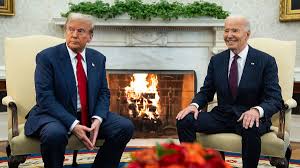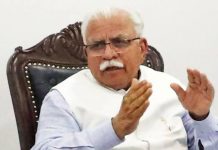The meeting between outgoing President Biden and President-elect Trump on November 11 marked a return to the tradition after 2020’s break, when Trump had declined to meet Biden. However the meeting lacked the traditional warmth by Gopal Misra

It was only natural for democracy enthusiasts to welcome the much-awaited two-hour meeting between outgoing President Joe Biden and President-elect Donald Trump on November 11. However, the meeting lacked the warmth typically associated with such transitions. While there was considerable media hype surrounding the inauguration of this transition process, it was evident that things would not proceed as smoothly as they had been portrayed.
Trump will be formally sworn in as president on January 20, 2025. While social events in Washington attract global attention, keen observers of political developments in world capitals are understandably apprehensive about the power transition. While the meeting was seen as a return to tradition—after the break from it in 2020, when Trump declined to meet Biden—some political decisions of a “lame-duck” President Biden have raised concerns. Biden’s actions, particularly his decision to provide Ukraine with additional weapons and funds, seem to undermine any peace initiatives Trump had promised to undertake during his campaign.
The transition process resembles a queen delivering a new heir to the throne, with shifting power dynamics emerging within the inner circles. As Biden, the “eighty-year-old emperor,” exits, the U.S. appears to be experiencing medieval political shifts. Although Trump was warmly received at the White House, with First Lady Jill Biden presenting him with a bouquet, the absence of Melania Trump did not go unnoticed. Many observers, familiar with her role as First Lady during Trump’s first term, believe she possesses an uncanny sixth sense. For years, men have been mystified by how women can sense unfaithfulness, and Melania’s absence in this historic moment only adds to that intrigue. During her presence in 2017-2021, she had performed her duties betraying her beauty blended with talent.
Biden’s substantial financial commitments before leaving office have also caught the world’s attention. Recently, it has been noted that his administration, despite offering limited assistance to victims of cyclones in Mexico, is committing large sums to Ukraine. Additionally, the announcement of a $4 billion allocation to the International Development Association (IDA), a subsidiary of the World Bank, appears to tie his successor to ongoing financial and strategic commitments. Another notable move is the decision by the IRS and U.S. Treasury to offer new tax credits for clean-energy projects, with credits set to begin on January 19, 2025, just one day before Trump’s inauguration!
Xi Jinping-Biden meet -It is difficult to gauge the outcome of the high-level meeting between President Joe Biden and Chinese President Xi Jinping, held on the sidelines of the Asia-Pacific Economic Cooperation summit in Lima, Peru. The meeting may have been little more than a ritual or perhaps a poignant farewell between two leaders who have shared mutual admiration since Biden’s vice-presidency. During the Barack Obama era, Biden served as vice-president, and he had met Xi Jinping—then holding a key position in China’s power structure—during a visit to Tibet.
Notably, just weeks before his anticipated departure from the political stage, Biden raised the Tibetan issue, which had long been on the backburner, urging Xi Jinping to open dialogue with the Tibetan leadership.
It is also difficult to interpret the implications of the recent release of Tibetan environmentalist Karma Sandrup, who had spent 15 years in jail, as well as the release of popular Tibetan poet Gendun Lhundrub after four years of imprisonment.
Biden and Xi Jinping however failed to address peace prospects in the ongoing conflicts in Eastern Europe and West Asia. Their discussions centered mostly on bilateral relations, particularly trade and manufacturing. This aligns with Biden’s approach of relying on China for manufacturing under U.S. companies, while Trump has promised to revive domestic manufacturing.
As Biden’s time in office draws to a close, the next eight weeks will be crucial, and much will depend on how the Biden administration navigates this final phase of the transition.
The next 50 days will be crucial for global peace, as outgoing President Biden further escalates the Russia-Ukraine conflict. His decision to allow Ukraine to use long-range missiles to strike Russian targets has provoked a revision of Russia’s nuclear doctrine, potentially leading to the use of mass destruction weapons against any nuclear power supporting Ukraine in its strikes on Russian soil.
Elon Musk’s shifting ties– It is unsurprising that Elon Musk has repositioned his political preferences in favour of Donald Trump. Market reports suggest that Tesla, his globally acclaimed electric car brand, has lost its shine in world markets to Chinese automaker BYD. Rather than directly competing with the Chinese manufacturer, Musk appears to hope that higher tariffs under a new administration will help him reclaim market dominance.
He seems to overlook the advice of Shenzhen-based Snow Bull Capital, which emphasised that “it is no longer about the size and legacy of auto companies, it is about the speed at which they can innovate and iterate.” In the ongoing competitive dynamics between Musk and BYD’s billionaire founder, Wang Chuanfu, it seems that, for now, the Chinese have the upper hand.













